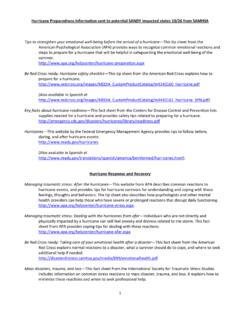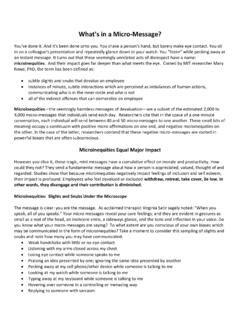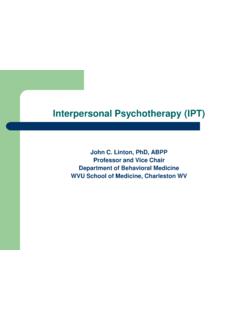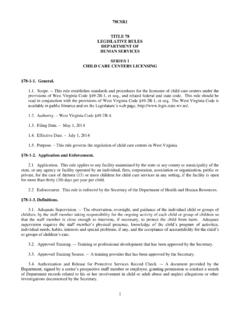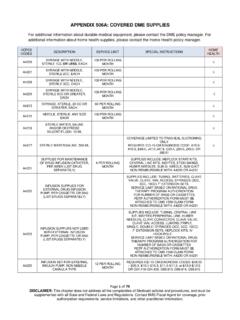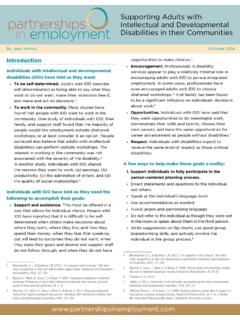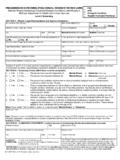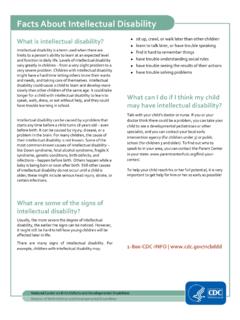Transcription of Trauma and People with Intellectual or Developmental ...
1 WEST VIRGINIA INTEGRATED BEHAVIORAL. HEALTH CONFERENCE. Trauma and People with Intellectual or Developmental disabilities : recognizing Signs of Abuse and Providing Effective Symptom Relief NORA J. BALADERIAN, Licensed Psychologist Director, Disability and Abuse Project;. Director, Trauma and Crime Victim Center of West Los Angeles Abuse & Neglect - Overview Approximately 25% of children with disabilities acquired the disability as a result of abuse. 52% of neglected children acquire a permanent disability. Vulnerability is mediated by Opportunity and Intent of the Perpetrator Over 90% of the perpetrators are in an authorized care providing position (parent, other family/household member, school personnel, work or home services).
2 Most frequently identified are: male, Family members, transporters, care providers Abuses most frequently occur at home, day activity (school, work) and transportation Lack of information & preparation of the individual and their family about this issue & what they can do to lessen vulnerability by planning for attempted &. completed maltreatment. How to Identify Abuse in People with disabilities Depends upon the type of disability the person has and Upon the type of abuse that occurred . Physical Abuse Signs of physical abuse in People with and without disabilities are the same. HOWEVER. Sometimes the signs of ABUSE are attributed to the DISABILITY.
3 And ignored Sometimes the disability causes conditions that mimic signs of ABUSE and are mistaken, causing parents & other care providers to erroneously by accused of abuse. Physical neglect (failure to provide medicine, food, water, assistive devices, etc.) may cause an exacerbation of the symptoms of the disability leading to temporary mental aberration, physical symptoms, coma and even death. Often People do not disclose the abuse for multiple fears and no apparent sign that help is available. Sexual Abuse Physical signs of sexual abuse are the same for both People with and without disabilities . HOWEVER, People with disabilities may not disclose the assault by the time they do, all physical signs are gone (except STD's and pregnancy of course).
4 People with cognitive disabilities may not show obvious signs of distress that expose the abuse, but may have changes in mood &. conduct that signal something has happened. People whose care provider is the perpetrator may show signs that no one sees or notices, or is attributed by the observer to causes other than assault. People assaulted in medical facilities (acute care hospitals for example) rarely disclose the abuse due to threats of death or other retribution by those who know their address and threaten direct harm. Signs of Emotional Abuse These are essentially the same as for People without disabilities , HOWEVER.
5 Verbal assaults, threats, and withholding of attention are powerful tools of abuse that are used but are difficult to prove , thus disclosure is delayed as the victim feels she has no proof . of what has occurred. Depression, withdrawal, anxiety, fears and re- enactments may be observed or suspected. Signs of Trauma Mood, conduct, communication Eating, sleeping, dressing skills/preferences Regression from skills already mastered Does not want to go to x location or with x person Questions related to sex, pregnancy are asked Signs of Trauma Clothes are changed, soiled or torn Change in monthly menstruation Onset of increased sexualized conduct Diarrhea or constipation Gain or loss of weight Signs of Trauma Indications of a sexually transmitted disease (STD).
6 Itching, burning, pain with urination/defecation Self-molestation (replicating assaultive act upon oneself). Acting out what was done to him/her (replicating the assaultive act upon others). Self-harm or mutilation Signs of Trauma Onset of new fears such as social anxiety, generalized anxiety, phobias Depression and sadness Irritability, anger Withdrawal Trouble thinking, concentrating, remembering Re-enactment & somatization Signs of Trauma Change in normal behavior & personality Self-injury Sleep disturbances Change in normal behavior & personality Regression to earlier Developmental stages Sleep disturbances Change in appetite Change in energy Signs of Trauma Change in interest in normal activities Difficulty learning Angry, irritable.
7 Easily frustrated Wanting to stay home Onset of lying Signs of Trauma Wanting to sleep with parents Signs of Post Traumatic Stress Disorder (PTSD). New disabilities psychiatric, physical, sensory, communication or other. Change in communication including selective mutism (when a previously verbal child stops talking after a Trauma .). How can you know for sure? ASK. Most People who have disabilities state that although they have been abused many times in their life, NO ONE ever asked about this aspect of their lives PLEASE be sure that you have something to offer if you decide to ask this question. Such as Time to listen to their story An effective response including reporting the abuse to the authorities Suggestions for help such as a GOOD referral to therapy, groups, books, pamphlets, videos, peer groups Don't just ASK then leave them in the memory of the tragedies they have survived.
8 What is the biggest enemy ? Negative attitudes toward People with disabilities . We are all products of our culture Our culture is disability-negative We all need to do personal work to discover then change any remaining negative attitudes sourced in myth and stereotype (sourced in fear and lack of contact). Barriers to Overcome Stereotypes blind us to seeing each person's individual needs while perceiving some imagined group characteristic. Stereotype: People with Down's Syndrome are all so loving and kind. Myths are false beliefs shared in a culture: Myth: People with profound mental retardation are not could not be sexual assault victims.
9 If a person with a disability is maltreated, it really doesn't effect the individual because the disability causes them not to have feelings or the same feelings as their peers who do not have disabilities . Attitudes, Stereotypes & to Crazy Thinking or Not thinking . Attitudes: Living in a disability-negative society, negative attitudes towards individuals with disabilities may underlie failures to address the needs of children & adults with disabilities that are usual fare . for their generic peers. (For example, awareness that individuals with disabilities are victimized through sexual assault and domestic violence and proactive efforts to help.)
10 Poor thinking occurs when a generic discussion is infused with the word disability , normal, rational thinking frequently goes example discussions of sexuality & normal sexual development. Physician performing a vasectomy on a teenager to preclude same sex orientation (multidisciplinary team decision). Over time, perpetrators have offered a variety of reasons for the sexual contact or denying the sexual contact: She came on to ME. It was consensual I was teaching her/him about sex I don't have a penis (wife did not concur). Or the staff colleagues, in one She's a nympho AND he is a GREAT guy How could I know he/she's disabled?




